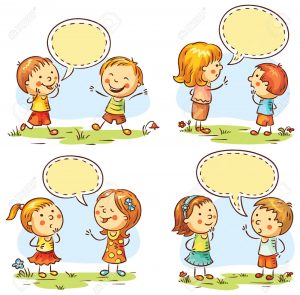
Blank Comics to Boost your Child’s Language
Blank Comics to Boost your Child’s Language
Conversation and talking are all about the exchange of information, ideas, feelings, beliefs, and thoughts. Here are some great ideas for using blank comics to boost language skills in your little ones.
Why would blank comics be interesting?
Illustrations tend to grab a child’s attention almost immediately. The characters in a comic strip, the background scene where it’s based, dialogue bubbles give the child a realistic picture of an everyday event. It’s a fun way to work on language skills with minimal print knowledge. You could also personalize the blank comics to boost the language skills of your child.
Understanding emotions and reactions
Comics are simple yet effective in depicting the feelings, emotions, and reactions of the characters involved in the story. Children tend to grasp visual depiction with ease. Comics often consist of exclamatory remarks, surprise, negation, etc. These help the children understand the right words and the right manner to respond in real-life conversations. You could get your little one to Fill up blank comics with appropriate emojis. This will help him/her understand the feelings and emotions, remarks, or words. Thus, helping him/her learn the correct usage of language in the context of a conversation or a specific situation.
Social Skills
 Social skills include a wide range of behavior. Some of them being initiating a topic to talk about, taking turns to talk, respond appropriately, ask appropriate questions, sticking to the topic of discussion. In early childhood, social skills expand to the use of comments, opinions, compliments, and terminating the discussion. A blank comic is an excellent tool to introduce all of these concepts. You can help your child use pictures of words to fill up the speech bubbles in the comics.
Social skills include a wide range of behavior. Some of them being initiating a topic to talk about, taking turns to talk, respond appropriately, ask appropriate questions, sticking to the topic of discussion. In early childhood, social skills expand to the use of comments, opinions, compliments, and terminating the discussion. A blank comic is an excellent tool to introduce all of these concepts. You can help your child use pictures of words to fill up the speech bubbles in the comics.
- Illustrations can help the child understand facial emotions better. Therefore, the pragmatics of language use becomes easier to teach with the help of these comic strips.
- Also, you could also help your child identify acceptable behavior and words versus unacceptable behavior and words.
- Encourage your child to think about thoughts and feelings through comic strips.
- Help them identify the effects of using negative words versus positive words for behavior modification in children.
- Teach how to deal with bullies, anger issues, requesting and taking turns in a playgroup, etc., through personalized blank comics.
- Any real-life incident could be put as a comic strip for the child. This will help him/her learn a language for everyday use.
Sequencing events and simple narrations
Comic strips are a great tool to introduce sequencing skills. For children with no or minimal reading skills, mere illustrations could be used to help them understand the sequence of events in a story form. Narration or story re-tell could then be elicited from the sequence of pictures.
Prediction
Going a step ahead from the narration and story re-tell, you could use the blank comics to encourage the prediction of events and utterances associated. Help the child identify key elements, understand the context and make multiple predictions of how the event could end or what a certain character in the story could say or react. Help them fill in words or remarks to complete this process.
Inference Making
Since inference-making is much easier with illustrations and pictures rather than text, think of using blank comics to teach a few skills. If your blank comic has a picture of a child pulling a face about the food in his hand, it is much easier to understand that the child does not like the food in his hand. The same thing in the form of a written story would be much more challenging to decode and understand. Drawing attention to the surroundings in a comic can help the child draw inferences about the characters, their roles, actions, feelings, and thoughts. Analyzing these aspects will help the child make judgments about what words or phrases to choose in a given situation.
Cause-Effect and Problem Solving
Understanding the ‘Why’ of an event can be targeted through blank comics. Since the most important aspects of a given situation are visually presented for analysis, it is easier to make connections and come to a conclusion. Once the child learns to decode the reasons for a particular event, he/she can think about possible solutions. Using words and language effectively depends upon mental abilities like thinking, reasoning, problem-solving, etc.
- For example, the use of words such as ‘because’, ‘if-then, ‘since’, ‘therefore’ could be taught through such exercises.
- Using the right questions in a conversation, responding with empathetic words, offering help, requesting information, requesting help and many other language skills are largely dependent on understanding the cause-effect and problem-solving.
Here are some ways you could personalize the blank comics to boost language:
- Firstly, make use of photographs of people your child knows and talks to
- Have your child express different emotions and photograph him/her. Use these photographs as emojis in the blank comics to help the child understand what a certain emotion looks like on the face and the reason behind feeling that emotion. This will help the child understand in responding appropriately or to verbalize feelings in the appropriate manner
- Use pictures of his/her everyday surroundings like home, school, park, etc. as the background for the comics.
- In addition, encourage your child to get creative- give him/her a choice to pick a voice for their character on the comic, an outfit, a superpower to make it more fun.
- You could also time travel with your child and encourage imagining a situation. For instance, help your child think about what they would talk about and how they would sound when they get old or if they were a baby and so on. This will develop social cognition and social skills for children to use language better.
Find more ideas from Speech Time Fun
A lot of children love looking at pictures and comics. Using these picture books and comics and personalizing them to suit the communicative needs of the child will help the child learn many skills including social skills, receptive language, expressive language, empathy, and pragmatics of language. In conclusion, remember that reading books and doing a few paper-pencil tasks could also be a lot of fun! Give it a try!
- “Interventions for children and adolescents with stuttering” - April 7, 2023
- What is Speech Therapy and its effect? - December 21, 2022
- Dysphagic disorder in a cohort of COVID-19 patients - December 13, 2022

Leave a Comment
(0 Comments)